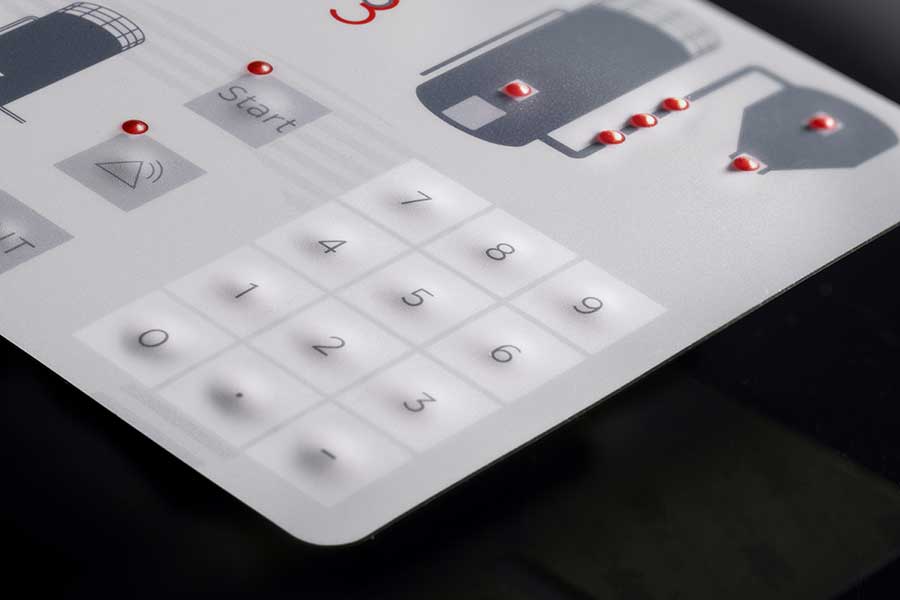Recognizing the Capability of Membrane Layer Changes for Individual User Interface Gadget
The capability of membrane layer switches over stands for a significant advancement in individual interface style, integrating performance with aesthetic convenience. These switches run with a multi-layered structure that equates individual communications into electrical signals, permitting both small formats and resilience against environmental aspects. As industries progressively prioritize customer experience, comprehending the subtleties of membrane layer switch innovation ends up being necessary. What effects do these innovations hold for future applications, and just how might they redefine customer communications across numerous devices?
What Are Membrane Layer Buttons?
Membrane buttons are cutting-edge interface gadgets that promote individual interaction with digital equipment. These functional components contain multiple layers, including a visuals overlay, spacer, and a printed circuit layer. The design permits a smooth combination into various digital gadgets, boosting both the aesthetic and functional elements of individual interfaces.
Membrane layer buttons are typically employed in a large range of applications, from family appliances to industrial machinery and medical gadgets. Their building and construction commonly includes a slim profile, making them an excellent choice for small designs. The responsive feedback given by these buttons can be crafted to satisfy specific individual choices, making certain reliable interaction in between the customer and the device.
Longevity is one more considerable advantage of membrane layer switches, as they are immune to dust, wetness, and chemicals, which improves their life-span sought after atmospheres. Additionally, these buttons can be tailored in terms of form, dimension, and graphic design, permitting branding and user-specific attributes. Overall, membrane layer switches stand for a functional solution for improving individual experience in electronic devices, combining performance with visual allure in an effective manner.
How Membrane Layer Switches Job
Operating on a straightforward principle, membrane layer switches over utilize a split construction to sign up user input efficiently. Each button consists of several layers, consisting of a published circuit layer, a spacer layer, and a top graphic layer, which are made to interact perfectly. When an individual presses the leading layer, it presses the spacer layer, bringing the conductive aspects of the circuit layer right into contact with each other.
This get in touch with develops a closed circuit, indicating the device to carry out a details function. The layout enables for numerous setups, consisting of tactile feedback, which can boost the user experience by offering a physical sensation upon activation. The materials used in membrane layer buttons frequently include versatile substratums, such as polyester or polycarbonate, which make sure toughness and durability versus damage.

Secret Advantages of Membrane Layer Switches

One more considerable benefit is their compactness. Membrane buttons are thin and light-weight, which makes it possible for suppliers to conserve space in their tools without sacrificing performance. This feature is especially helpful in applications where weight and quantity are critical considerations.
Furthermore, membrane layer buttons are immune to dust, wetness, and chemicals, improving their sturdiness. This durability extends their life-span and decreases the demand for regular replacements, leading to cost savings in time.
Moreover, the responsive comments offered by membrane buttons can be optimized to improve individual communication. They can include features such as increased switches or distinct clicks, enhancing use and customer experience.
Applications Across Industries
Interface tools utilizing membrane layer buttons are common in a vast selection of sectors, showcasing their flexibility and functionality. Membrane Switch. In the medical industry, membrane buttons are integral to tools such as analysis devices and person monitoring systems, where their durability and convenience of cleansing are important for maintaining health standards. Similarly, in the automobile market, these buttons are employed in dashboard controls and infotainment systems, giving a smooth and modern-day interface for customers.
Additionally, the customer electronics sector gain from membrane layer buttons in appliances and handheld gadgets, where small layout and easy to use interfaces enhance customer experience. more Industrial applications also take advantage of membrane layer switches over for control board in equipment and automation systems, emphasizing their effectiveness and resistance to harsh settings.
In the aerospace and defense industries, membrane switches are made use of in cockpit controls and tools, where reliability and performance under severe conditions are vital. Furthermore, the pc gaming industry significantly includes membrane layer buttons in controllers and game devices, adding to an appealing individual experience. On the whole, the convenience of membrane switches enables their widespread usage throughout countless sectors, emphasizing their significance in modern interface layout.
Future Fads in Membrane Switch Innovation

Furthermore, making use of sophisticated products, such as polycarbonate and polyester movies, is expected to rise, providing boosted resilience and resistance to ecological stressors. These materials add to the total durability of membrane switches, making them appropriate for harsher industrial applications.
In addition, the consolidation of smart innovation, consisting try here of IoT connection, will make it possible for membrane layer buttons to connect with various other tools and systems, assisting in a more interactive individual experience. This trend lines up with the growing demand for wise tools across various markets, from healthcare to consumer electronics.
Finally, personalization options are anticipated to increase, enabling manufacturers to develop bespoke services customized to particular user requirements and preferences. These advancements will certainly position membrane layer switches as vital elements in the advancement of interface innovation.
Verdict
To conclude, membrane switches over stand for a pivotal development in interface innovation, using a reputable and functional option for Resources varied digital applications. Their layered building and construction promotes compact style, while functions such as tactile responses boost user interaction. The sturdiness against environmental variables even more solidifies their utility across multiple markets. As improvements in product scientific research and touch picking up modern technologies continue, the capability and applicability of membrane buttons are anticipated to expand, strengthening their significance in modern electronic tools.